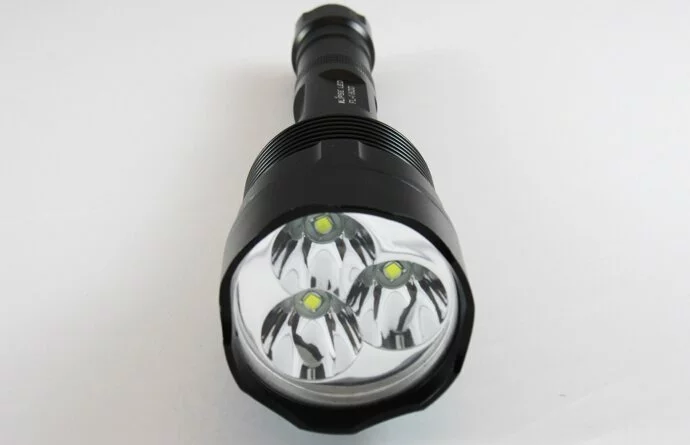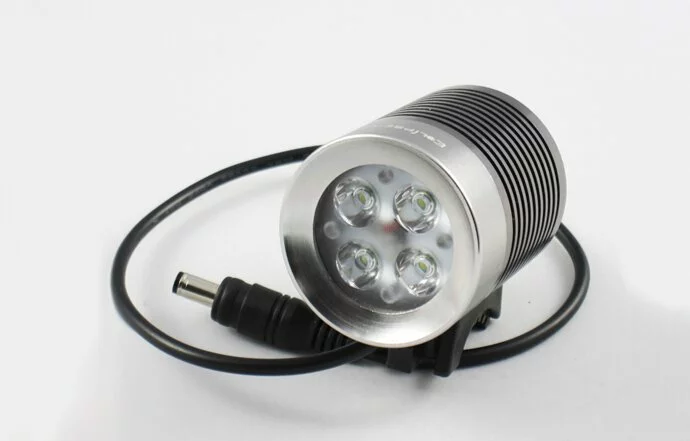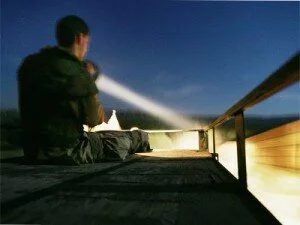 The United States Border Patrol is showing interest in LED lighting technology. With the US borders being so spread out and even inaccessible in many areas, the federal government cannot keep enough Border Patrol agents on staff to keep the border one hundred percent secure all the time. The US border is a barely discernible line in uninhabited deserts, canyons, or mountains–shared with Mexico and Canada. The Border Patrol relies on a variety of equipment and methods, such as electronic sensors placed at strategic locations along the border, to detect people or vehicles entering the country illegally. Video monitors and night vision scopes are also used to detect illegal entries. Agents patrol the border in vehicles, boats, aircraft, and afoot. In some areas, the Border Patrol employs horses, all-terrain motorcycles, bicycles, and snowmobiles; all while air surveillance is provided by unmanned aerial vehicles or UAVs. With so many modes of patrol, agents need the most efficient means and equipment to perform their job effectively.
The United States Border Patrol is showing interest in LED lighting technology. With the US borders being so spread out and even inaccessible in many areas, the federal government cannot keep enough Border Patrol agents on staff to keep the border one hundred percent secure all the time. The US border is a barely discernible line in uninhabited deserts, canyons, or mountains–shared with Mexico and Canada. The Border Patrol relies on a variety of equipment and methods, such as electronic sensors placed at strategic locations along the border, to detect people or vehicles entering the country illegally. Video monitors and night vision scopes are also used to detect illegal entries. Agents patrol the border in vehicles, boats, aircraft, and afoot. In some areas, the Border Patrol employs horses, all-terrain motorcycles, bicycles, and snowmobiles; all while air surveillance is provided by unmanned aerial vehicles or UAVs. With so many modes of patrol, agents need the most efficient means and equipment to perform their job effectively.
Illegal immigrants are finding more and more effective methods to avoid detection while crossing the borders. Obviously the cover of darkness is the most favorable cloaking device for migrating. Border Patrol agents are keen to even the most elusive tactics employed by these immigrants and in response are upgrading their arsenal of weapons and equipment. The first and most valuable tool for night patrols is adequate lighting and optical equipment. “Being able to spot a moving or inanimate object 150 yards away, in the pitch dark of night, with a flashlight, is more than impressive for us, it’s a pivotal necessity,” explains Border Patrol Sgt. John Miller.
LEDs are also being incorporated into NVIS or Nigh Vision Imaging Systems. Willbrecht LEDCO, Inc. has introduced new NVIS compatible LEDs for its CRM series panel LED indicators. These new NVIS LEDs are a perfect fit for variety of military, UAV, and Border Patrol applications. Everyday, LED Flashlights, LED Headlamps, and LED Off Road lights are becoming brighter, more lightweight and durable. Having brighter lighting equipment and better optical tools has proven to aid the Border Patrol agents in way thought impossible in the past. Just ten years ago the thought of a handheld flashlight emitting 1500 to 2000 lumens seemed farfetched. However, today there are a plethora of options for lighting accessories at affordable prices. Even the implementation of LED Bike Lights has made its way onto the scene for Border Patrol agents on bicycles and motorcycles.
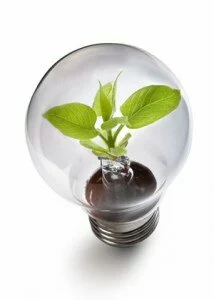 “We can create a more sustainable, cleaner and safer world by making wiser energy choices.”
- Robert Alan Silverstein
“We can create a more sustainable, cleaner and safer world by making wiser energy choices.”
- Robert Alan Silverstein
There looms a big question with the sudden uprising of LED lighting technology- can it translate to better more economical lighting for horticulture. The short answer is “yes.“ However, the more drawn-out explanation stands, “not right now.” There have been so many LED breakthroughs in the last five to ten years that most non-industry consumers think that LED technology is the answer for all things lighting, and some things non-lighting– one of the biggest industries being the food industry. Food is so important, and it should be so abundant, but there are too many mouths to feed, and frankly never enough money or power to be had (tangent). With rising food prices and a limited area to farm, governments and private companies everywhere have turned to indoor or greenhouse growing options for producing food in abundance year round. These options provide better control over environmental factors and pest/disease problems by controlling almost all factors of growth, including the most important, light energy.
Light is critical to a plants success because it is the primary source for the plants’ metabolism energy– a direct role in how well the plant grows, eventually leading to a high or low harvest index. The harvest index is the bottom line for crop farmers. In lieu of sunlight, farmers need artificial lighting, and light deprivation techniques to grow certain plant varieties. A proper lamp is needed for so many reasons, and efficiency seems to be on everyone’s mind.
HID or High Intensity Discharge lamps such as High Pressure Sodium and Metal Halides, are reaching a peak in efficiency. They emit an incredible amount of light in the appropriate spectra, but the cost is high electricity. This is where LEDs step into the picture, given only one or two steps for now. LED technology is rapidly improving and becoming more efficient. The amount of electrical energy needed to convert into light energy is becoming less and less. This translates into more light for less cost. On top of the efficiency, there are spectral benefits as well, including the possibility of engineering the most efficient lighting spectrum to grow plants, without wasting energy on color wavelengths that are not necessary to critical plant processes. The down side to LED lighting for horticultural application is the size of the diodes and coverage they offer. To effectively cover a large area such as a greenhouse, there needs to be an array of LEDs. Because LEDs are a point-source light, they are only really powerful in large quantities, with each diode emitting at the correct angle. Point-source lighting means they offer uni-directional illumination, where a traditional HID lamp effectively emits 360 degrees, and all from a single source. In this case, LED lights are better suited for visual illumination such as LED Bike Lights, LED Headlamps, LED Flashlights, or Off Road LED Lights. This type of lighting makes for great illumination effect, but is still lacking in the area of crop growth.
The first indoor and greenhouse plants grown under artificial light weren’t the best quality, and traditional growers probably criticized the early lighting setups like today’s HID growers criticize LED’s. We’re currently witnessing the beginning of a revolution in lighting that’s as significant as the one that originally allowed horticulture to move indoors.
When LEDs reach a point where they are emitting 320 or more lumens per watt, they will be considered for mass crop growth. At that point the energy needed from a single point-source light will begin to rival that of the HID systems now in use. Solid State Lighting (LEDs) is an excellent option for an energy saving-Green lighting market, but until there is a jump in efficiency, they most likely will not be a viable option for the Goliath food industry.
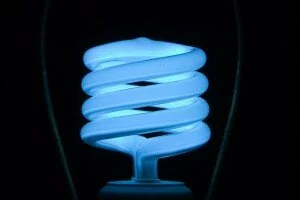 “Our goal should be to create a world with abundant, clean and cheap energy for all. This is an objective that reconciles progress and planet. It’s a challenge that can bring rich and poor countries together in a common goal. If we are to address climate change, we must turn to humanity’s familiar benefactor, technological innovation, and apply it to developing better clean energy.” - Alex Trembath
“Our goal should be to create a world with abundant, clean and cheap energy for all. This is an objective that reconciles progress and planet. It’s a challenge that can bring rich and poor countries together in a common goal. If we are to address climate change, we must turn to humanity’s familiar benefactor, technological innovation, and apply it to developing better clean energy.” - Alex Trembath
Consider the hidden benefits of LED lighting over the traditional incandescent, fluorescent and HID lighting methods.
In an era of “green”, energy efficient and environmentally friendly lighting, the LED lights such as LED Bike Lights, LED Flashlights, LED Headlamps, LED room/flood lights and Off Road LED Lights are far superior in obvious ways. LED light advantages include greater efficiency (approximately 1/5th the power consumed compared to a comparable incandescent bulb of same light output) improved LED life of up to 50,000 hours, little to no radiated heat and they will light in any temperature (fluorescents “flutter” with a low light output in cold temperatures).
LED lighting also has a definite advantage on the environmental impact scale. There is no glass to break and no mercury to pollute the environment, such as contained in fluorescent and CFL bulbs.
The hidden benefit of the LED is the “clean” light it gives off compared to traditional lighting. Recent and ongoing studies have proven that the CFL bulb emits a “dirty” light output consisting of high levels of UV and RF frequencies. This “dirty” light output is shown to cause skin disorders on sensitive skin patients, migraine headaches, sleeping problems, etc., increasing in patient numbers as more and more CFLs are sold due to government restrictions on incandescent light bulbs. CFL “dirty” output levels are 90 times higher (450-500) than in LEDs (5-10) and 22 times higher than in incandescents (20-25).
A level of “50” is considered a safe level.
So before you rush out to buy a basket full of “energy saving” light bulb replacements in hope of cutting electricity costs, consider the downside to CFL and other Fluorescent lighting sources – health issues resulting from harmful RF waves. Deciphering which lights are truly causing a negative health impact needs to be tested using specific equipment, not including Lumen Testing measurements, but actual RF levels.
These kinds of improvements in lighting can be used for a plethora of health related applications including hospital and wellness center implementation. But the real benefits will be seen in residential applications, and energy costs can be reduced even more by switching to LEDs
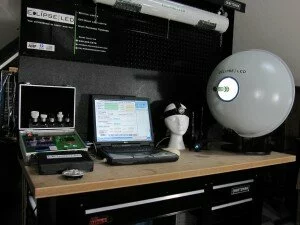 “An element of exaggeration clings to the popular judgment: great vices are made greater, great virtues greater also; interesting incidents are made more interesting, softer legends more soft.” –Walter Bagehot
“An element of exaggeration clings to the popular judgment: great vices are made greater, great virtues greater also; interesting incidents are made more interesting, softer legends more soft.” –Walter Bagehot
It seems like yesterday, today, and tomorrow is filled with exaggerated product claims and in the lighting industry it’s luminous output. As the story goes, great deals of foreign and domestic lighting manufacturers are players in the “most powerful lamps” and “we are the brightest and largest” game. Reality is however these lumen claims are either greatly over exaggerated and based on a theoretical number, or an outright lie.
In the case of LEDs, the claims have skyrocketed, sometimes reaching double or even triple the actual Out The Front Output of said product. There are few regulations preventing these claims for LED Bike Lights, LED Flashlights, LED Headlamps, and Off Road LED Lights. There seems to be little accountability for these high output lumen claims, especially regarding Asia based manufacturers. Because everyone wants to see a low price and a high lumen output; so instead of companies bumping prices, they will exaggerate lumen output, usually basing their numbers on the LED chips’ theoretical output. It almost goes without saying though, that these outputs are based on almost perfect conditions that will never be matched in practical use situations. What needs to be implemented are standardized Lumen Testing services and regulations.
There are a handful of lighting manufacturers who have implemented and helped developed a standard for testing products. The ANSI NEMA FL-1 test is gaining recognition as a base for quality control claims in the recreational lighting world. The NEMA FL-1 test has been standardized, and should be the same when performed by certified testing facilities anywhere in the world. The test features criteria ranging from Lumen Testing to Water Resistance ratings.
With testing like the ANSI NEMA FL-1 procedure slowly being adopted by quality-first manufacturers, the customer won’t have to scratch their heads wondering whether or not they’re getting what is claimed on the website or box. So if you’re tired of being lied to and what to stand against the “lumens claim game”, the next time you are in the market for LED Bike Lights, LED Flashlights, LED Headlamps, or Off Road LED Lights, be sure to check to see if the product has the FL-1 rating it deserves.
 “The sun is gone, but I have a light” –Kurt Cobain
“The sun is gone, but I have a light” –Kurt Cobain
It’s difficult to imagine another commodity besides light that can hold a candle, pun intended, to the other half of the day, night. The lighting industry is multi-billion dollar revenue with room to stretch its legs. They’re not going anywhere, because neither is darkness. With a problem comes a solution, and with time comes more efficient methods in which to employ that solution.
The efficiency we are perpetually achieving with energy is astounding– how much can we harness in the form of light?
It seems to be a lot, especially with the ‘Green Movement’ in the lighting industry. First stop, LEDs– a powerhouse contender for the most progressive form of modern day light sourcing. With energy costs soaring and the concern for the environment at an all time high, people are looking to efficient lighting as one of the outlets to help pinch pennies and reduce their carbon footprint. With nano-technology and standardized Lumen Testing becoming evermore present in the development of consumer products, LEDs have only made headway in the efficient lighting department.
LEDs are replacing the traditional incandescent and even fluorescent lighting options, not just in commercial applications, but in almost any other field in the lighting industry including, LED automotive lights, LED Bike Lights, LED Flashlights, LED Headlamps, and Off Road LED Lights for UTVs, and even in horticultural applications. It’s hard for modern society to truly appreciate the brilliance behind LEDs and their almost unlimited growth potential. Now that the source for the LED “droop” factor has been discovered and minimized, the restraint on luminous efficacy has been lifted. For “droop” clarification please see “LED efficiency puzzle solved by theorists” article from Physorg.com.
Imagine, now you can easily hold the power of 200 candles in the palm of your hand. This may not sound too exciting, but even the headway made in LED Flashlights in the last 5 years is literally a multitude of difference compared to 10 years ago. To really appreciate this jump in lighting technology, just compare your old Mag-Lite® with a 400 or better yet 1600 lumen flashight– you’ll be waiving “goodbye” to the old light before you switch ‘off’ the new one.
 “Who are businesses really responsible to? Their shareholders? Their customers? Their employees? None of the above, I have finally come to believe. Fundamentally, businesses are responsible to their resource base. Without a healthy planet there are no shareholders, no customers, no employees. As the conservationist David Brower liked to say, ‘There is no business to be done on a dead planet.’ “–Yvon Chouinard, founder Patagonia Inc., 1% For The Planet Inc.
“Who are businesses really responsible to? Their shareholders? Their customers? Their employees? None of the above, I have finally come to believe. Fundamentally, businesses are responsible to their resource base. Without a healthy planet there are no shareholders, no customers, no employees. As the conservationist David Brower liked to say, ‘There is no business to be done on a dead planet.’ “–Yvon Chouinard, founder Patagonia Inc., 1% For The Planet Inc.
As a business with ties into the ever-evolving technology field, Eclipse LED has rooted itself in an efficient means of existence and not just as a company built around an efficient lighting source. Eclipse LED pledges 1% of its annual net profit to non-profit organizations, 1% For The Planet and Athlete Recovery Fund. Eclipse LED is not alone; they are flanked by thousands of other progressive businesses across the globe, all linked together in common goals and business ethics.
Examining different business models in today’s global economy, one can spot a trend between the companies who are leading their markets in progress. Sustainability. This concept is multi-faceted, and important on each tier of its implementation– starting with the environment. It’s more than an ideology to begin building your business from the Earth up. Designing your company’s business model around the environment automatically places it on the road to success because of the sheer nature of the direction the global economy is moving toward. Sustainability and energy conservation have become headline issues in the past fifteen years, from solar energy to organic farming techniques. It’s more than profitable; it’s one hundred percent necessary in order to conserve the environment and to forward technology– to protect AND to flourish.
Borrowing from our friend Yvon, here are some key points we believe are crucial to in order for corporations to be sustainable and to thrive. This isn’t necessarily a practical checklist, but more the philosophical reasoning points behind corporate responsibility.
Step 1: Lead an examined life. A major cause of environmental damage, and in return technological cessation, is ignorance. Ignorance is deliberate when people avoid confronting problems and when we as inhabitants of the Earth refuse to learn because we don’t want to have to start acting on what we know.
Step 2: Clean up your act. Once we’ve learned the environmental costs, we should naturally try to reduce them. Whether this means sourcing sustainable resources, such as recycled aluminum for your LED Flashlights and LED Headlamps, or waiting to bulk ship your LED Bike Lights or Off Road LED Lights product. People love to figure out how to do the right thing, once they know what that is.
Step 3: Do your penance. No matter the diligence of your business, you are causing waste and pollution. It is almost impossible to be completely neutral on the waste and pollution front. However, once a company has started the process of minimizing its footprint, it still has “back-taxes” owed to the environment and humanity. This is the penance for its sins. Find a sensible avenue to redeem your business in the meantime. This could come in the form of monetary donation to non-profit organizations such as 1% For The Planet, or simply giving your employees days off to volunteer for environmental or humanitarian causes.
Step 4: Support civil democracy. It’s small groups that can change the minds of large entities. A thousand diverse activist groups, each passionately working on a specific problem, can accomplish more than bloated, cautious NGOs or governments addressing every issue at the once. Learn from nature– nature loves diversity and hates monolithic and stagnate centralization.
Step 5: Influence other companies. If you can begin to grasp the previous steps, this one should be natural. A company that can find ways to be more efficient in its endeavors while balancing the platform of environmental responsibility has a moral obligation to spread this ideology to others.
Eclipse LED has been and will continue to be committed to these principles. We have adhered to the idea of “responsible” business on many fronts, including sustainable resources, rigorous safety and Lumen Testing, non-profit donation campaigns, progressive technological endeavors, and much more. It takes courage to pursue this mode of business, and it’s difficult to process through the status-quo business model. But nonetheless it’s important… it’s a start.
 “In wisdom gathered over time I have found that every experience is a form of exploration.”
“In wisdom gathered over time I have found that every experience is a form of exploration.”
― Ansel Adams
So you want to leave the mundane day-to-day. You want to get out and explore, maybe even a first ascent. Good, now go out and do it.
“But I have work, too many things to finish before I…” This is always going to be the case; there will never be the “perfect” time to make your move on this idea. There will always be some reason not to do something. This is where you take a leap of faith, pick up a pen and paper, and then proceed to jot down a plan to exit your current condition. Once you’ve taken this first step, you’ve completed the most important step– overcoming the common fear of “loss”.
An essay covering the topic of “loss” could go on for pages and pages… something that there isn’t enough time to cover in this blog. But just keep that concept in mind as we progress through the ideology that carries ideas such as a ‘first ascent’.
In 2010, a group of three friends decided to take this ideology and bring it to life with a cycling trip of a lifetime. Ace, Julie, and Davin all being avid cyclists, brought a plan and a dream to fruition. Realizing they all wanted to do something out of the ordinary and close to their hearts, they landed on a trip cycling from Northern California to Central and South America.
There are only simple goals here, from their own mouths: “searching for local movements that focus on community. [Their] route will be determined by word of mouth and capture the adventures these individuals find along the way.” In the process they decide that the magnitude of this kind of trip and/or idea needs to be documented. Et voilà, a documentary film, “Revolutions Southward” is born.
Even though this crew only made it to Mexico City, the dream and goal was realized via impromptu side routes, acquaintances, and dozens of stories usually found in fictional novels. More importantly, they conquered the common fear of venturing out and away from the daily grind. This is seen and made evident in their blog here.
Even though a bike trip from California to Mexico isn’t technically a “first ascent,” the courage behind it reflects a sense of vertical movement needed by the vast majority stuck in a lateral system. Bringing yourself to this level on a regular basis requires some training, and isn’t easily processed by the normal brain. Our biggest fears of “loss” are put to the test; we are face to face with the battle between what’s lost and what’s gained. However, the decision to bound forward brings with it an instant victory; you have just made your own “first ascent”. Don’t lose momentum, see it through, and make another.
 CRI or Color Rendering Index plays an integral role in many lighting applications. The color rendering index is a tool used by manufacturers to scale the ability of lighting sources to render color as it pertains to the rendering ability of natural lighting sources. The higher the CRI value (1-100 scale), the better the artificial source is in rendering colors.
CRI or Color Rendering Index plays an integral role in many lighting applications. The color rendering index is a tool used by manufacturers to scale the ability of lighting sources to render color as it pertains to the rendering ability of natural lighting sources. The higher the CRI value (1-100 scale), the better the artificial source is in rendering colors.
The color rendering index has goes beyond Lumen Testing and has been mainly of interest to color-critical applications such as photography or cinematography. With these applications it is crucial that the lighting source give an accurate representation of colors as they would be in natural lighting conditions. Even though CRI is only relevant to a given Kelvin color temperature parameter, it makes sense for outdoor recreational based lighting companies to base their CRI claims around the Sun’s kelvin range (5000-6000K). Taking this into consideration allows LED Bike Lights, LED Flashlights, LED Headlamps, and Off Road LED Lights users a base for relevancy and accuracy when choosing their lighting product.
Why should a high CRI light source matter for outdoor recreation you ask? Whether you’re walking, riding, or driving, the Sun’s light will be constantly changing in intensity, color temperature, and light angle. All of these factors will create visual difficulties, whether it’s shadows or misperceived objects– the difference between a rut and a rock. A properly balanced light will incorporate a high CRI level to distinguish subtle differences and help illuminate your path.
LED lighting sources are progressing swiftly with their ability to effectively render colors in the natural lighting spectrum. Look for an LED device (LED Bike Lights, LED Flashlights, LED Headlamps, and Off Road LED Lights) with a CRI around 80 to 95 and with a kelvin temperature in the range of 5000 to 6000K and make your outdoor excursion that much more safe and vivid.
 The United States Border Patrol is showing interest in LED lighting technology. With the US borders being so spread out and even inaccessible in many areas, the federal government cannot keep enough Border Patrol agents on staff to keep the border one hundred percent secure all the time. The US border is a barely discernible line in uninhabited deserts, canyons, or mountains–shared with Mexico and Canada. The Border Patrol relies on a variety of equipment and methods, such as electronic sensors placed at strategic locations along the border, to detect people or vehicles entering the country illegally. Video monitors and night vision scopes are also used to detect illegal entries. Agents patrol the border in vehicles, boats, aircraft, and afoot. In some areas, the Border Patrol employs horses, all-terrain motorcycles, bicycles, and snowmobiles; all while air surveillance is provided by unmanned aerial vehicles or UAVs. With so many modes of patrol, agents need the most efficient means and equipment to perform their job effectively.
The United States Border Patrol is showing interest in LED lighting technology. With the US borders being so spread out and even inaccessible in many areas, the federal government cannot keep enough Border Patrol agents on staff to keep the border one hundred percent secure all the time. The US border is a barely discernible line in uninhabited deserts, canyons, or mountains–shared with Mexico and Canada. The Border Patrol relies on a variety of equipment and methods, such as electronic sensors placed at strategic locations along the border, to detect people or vehicles entering the country illegally. Video monitors and night vision scopes are also used to detect illegal entries. Agents patrol the border in vehicles, boats, aircraft, and afoot. In some areas, the Border Patrol employs horses, all-terrain motorcycles, bicycles, and snowmobiles; all while air surveillance is provided by unmanned aerial vehicles or UAVs. With so many modes of patrol, agents need the most efficient means and equipment to perform their job effectively.



 “The sun is gone, but I have a light” –Kurt Cobain
“The sun is gone, but I have a light” –Kurt Cobain “Who are businesses really responsible to? Their shareholders? Their customers? Their employees? None of the above, I have finally come to believe. Fundamentally, businesses are responsible to their resource base. Without a healthy planet there are no shareholders, no customers, no employees. As the conservationist David Brower liked to say, ‘There is no business to be done on a dead planet.’ “–Yvon Chouinard, founder Patagonia Inc., 1% For The Planet Inc.
“Who are businesses really responsible to? Their shareholders? Their customers? Their employees? None of the above, I have finally come to believe. Fundamentally, businesses are responsible to their resource base. Without a healthy planet there are no shareholders, no customers, no employees. As the conservationist David Brower liked to say, ‘There is no business to be done on a dead planet.’ “–Yvon Chouinard, founder Patagonia Inc., 1% For The Planet Inc. “In wisdom gathered over time I have found that every experience is a form of exploration.”
“In wisdom gathered over time I have found that every experience is a form of exploration.”

